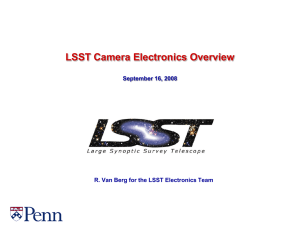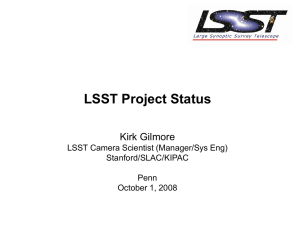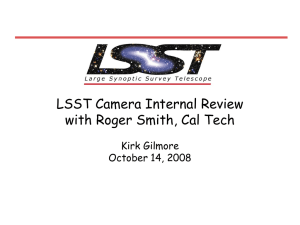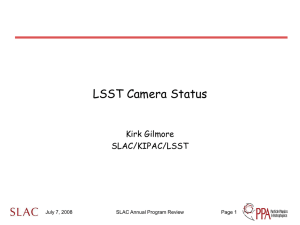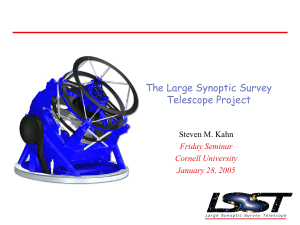SPIE Charts - GLAST at SLAC
advertisement
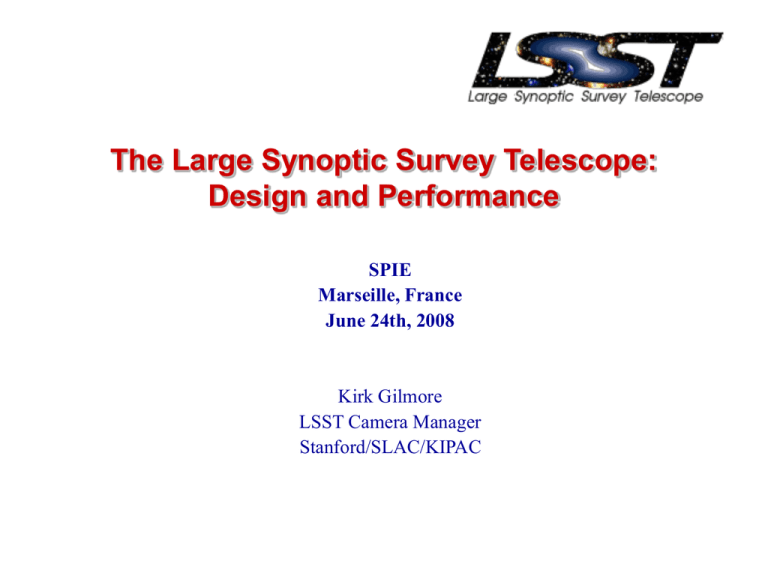
The Large Synoptic Survey Telescope: Design and Performance SPIE Marseille, France June 24th, 2008 Kirk Gilmore LSST Camera Manager Stanford/SLAC/KIPAC Science Objectives Drive System Requirements ________________________________________________ • Dark Energy / Matter –Weak lensing - PSF –Shape/ Depth / Area –Super Novae + Photo z –Filters (ugrizy) • Image Quality • f/1.25 beam • Large focal Plane Four Main Science Themes for LSST: 1. Constraining Dark Energy and Dark Matter 2. Taking an Inventory of the Solar System 3. Exploring the Transient Optical Sky 4. Mapping the Milky Way Major Implications to the Camera: 1. 2. 3. 4. Large Etendue Excellent Image Quality and Control of PSF Systematics High Quantum Efficiency over the Range 320 – 1,050 nm Fast Readout 3 LSST Concept QuickTime™ and a decompressor are needed to see this picture. Design Telescope and Camera as a Single Instrument • 8.4 Meter Primary Aperture – 3.4 M Secondary – 5.0 M Tertiary • 3.5 degree Field Of View • 3 Gigapixel Camera – 4k x 4k CCD Baseline – 65 cm Diameter – Six Filters • 30 Second Cadence – Highly Dynamic Structure – Highly Parallel Readout • Accumulated depth ~27 mag. in each filter over 10y • Data Storage and Pipelines ~ 18Tb/night! LSST Optical Design ________________________________________________ Image diameter ( arc-sec ) • f/1.23 • <0.20 arcsec FWHM images in six bands: 0.3 - 1 mm • 3.5 ° FOV Etendue = 319 m2deg2 Polychromatic diffraction energy collection 0.30 0.25 0.20 0.15 0.10 0.05 0.00 0 80 160 240 320 Detector position ( mm ) U 80% G 80% R 80% I 80% Z 80% Y 80% U 50% G 50% R 50% I 50% Z 50% Y 50% LSST optical layout LSST Camera Optical Design ________________________________________________ LSST Deliverable Org Chart ________________________________________________ Electronics Oliver (Harvard) WBS 3.5.8 Optics Olivier (LLNL) WBS 3.5.5 Sensor/Raft Development Radeka/O’Connor (BNL) WBS 3.5.4 Cryostat Assembly Schindler (SLAC) WBS 3.5.7 Camera Body Mechanisms Nordby (SLAC) WBS 3.5.3 Calibration Burke (SLAC) WBS 3.5.1 Data Acq. & Control Schalk (UCSC) WBS 3.5.6 Utilities Nordby (SLAC) WBS 3.5.2 Corner Raft WFS/Guider Olivier (LLNL) WBS 3.5.9 Sensors/Filters Pain/Antilogus (IN2P3) LPNHE, LAL, APC, LPSC, LMA LSST Camera Team ________________________________________________ Brandeis University J. Besinger, K. Hashemi Brookhaven National Lab S. Aronson, C. Buttehorn, J. Frank, J. Haggerty, I. Kotov, P. Kuczewski, M. May, P. O’Connor, S. Plate, V. Radeka, P. Takacs Florida State University Horst Wahl Harvard University N. Felt, J. Geary (CfA), J. Oliver, C. Stubbs IN2P3 - France Detailed in IN2P3 section of this report Lawrence Livermore National Lab S. Asztalos, K. Baker, S. Olivier, D. Phillion, L. Seppala, W. Wistler Oak Ridge National Laboratory C. Britton, Paul Stankus Ohio State University K. Honscheid, R. Hughes, B. Winer Purdue University K. Ardnt, Gino Bolla, J, Peterson, Ian Shipsey Rochester Institute of Technology D. Figer Stanford Linear Accelerator Center G. Bowden, P. Burchat (Stanford), D. Burke, M. Foss, K. Gilmore, G. Guiffre, M. Huffer, S. Kahn (Stanford), E. Lee, S. Marshall, M. Nordby, M. Perl, A. Rasmussen, R. Schindler, L. Simms (Stanford), T. Weber University of California, Berkeley J.G. Jernigan University of California, Davis P. Gee, A. Tyson University of California, Irvine D. Kirkby University of California, Santa Cruz T. Schalk University of Illinois, Urbana-Champaign J. Thaler University of Pennsylvania M. Newcomer, R. Van Berg Wayne State University David Cinabro Camera Layout ________________________________________________ Cryostat Filter Changer Filter L1/L2 Assembly Shutter From sensors to rafts to raft/towers The heart of the system ________________________________________________ CCD thermal straps FEE boards PACKAGED CCD cooling planes connector CCD housing (cold mass) carrier alignment pins TOWER RAFT • 3 x 3 submosaic of CCDs • front end electronics • thermal management components baseplate 3-pt. mount • Tower is an autonomous, fully-testable 144 Mpixel camera LSST focal plane sensors ________________________________________________ QuickTime™ and a decompressor are needed to see this picture. BNL and sensor group are providing leadship For sensor development ________________________________________________ • Request for proposals for prototype science CCDs – issued Feb. 2008 – contract award June 2008 • 5 high-resistivity, thick CCDs from study program have been extensively characterized – design models validated – behavior of dark current, quantum efficiency, and point spread function vs. thickness, temperature, and electric field – flatness and surface morphology – antireflection coating -50V • CCD controllers for 4 new test labs under construction – UC Davis, SLAC, Paris, Purdue – allows full-speed testing of segmented sensors • Components for CCD/electronics chain testing in assembly (Raft/Tower electronics) X-ray images -10V Raft tower electronics partitioning/temp zones ________________________________________________ Molecular Flow Barrier 32-port CCD 32-port CCD 3x3 - 16-port CCDs ~185K ~175K Front End Boards (6 per raft): • 144-channels of video signal chain through CDS processing • clock and bias drive • ASIC-based (ASPIC/SCC) Cryo Plate (~170k) Flex cables (~ 500 signals) Cold Plate (~230k) ~235K BEE motherboard and backplane: • differential receiver • signal chain ADC (16+ bits) • buffers • data transport to optical fiber • clock pattern generation • clock and bias DACs • temperature monitor / control RFP for Prototyping Filters in 08 ________________________________________________ Specs Half-Maximum Transmission Wavelength • 75 cm dia. • Curved surface • Filter is concentric about the chief ray so that all portions of the filter see the same angle of incidence range, 14.2º to 23.6º LSST Ideal Filter Set 100.0 System Throughput (%) 90.0 80.0 70.0 • Filter RFP being sent out to selected vendors 60.0 50.0 u g r i z y 40.0 • Filter prototyping will qualify vendors to fabricate science filters 30.0 20.0 10.0 0.0 300 400 500 600 700 800 Wavelength (nm) 900 1000 1100 Contamination test chamber at SLAC ________________________________________________ Sample Preparation FORE Chamber Outgassing Analysis Main MAIN Chamber Chamber Optical Transmission ANTE Chamber Sample Entry Fore or Preparation Chamber Optical Entry StraightThru Valve StraightThru Valve cold finger IN2P3 France R&D ________________________________________________ QuickTime™ and a decompressor are needed to see this picture. CNRS - National Center for Scientific Research IN2P3 - National Institute for Nuclear Physics and Particle Physics APC - Lab for Astroparticles and Cosmology (Paris) CC-IN2P3 - Computing Center of IN2P3 (Lyon) LAL - Lab of Linear Accelerator (Orsay) LMA - Lab of Advanced Materials (Lyon) LPSC - Lab for Subatomic Physics and Cosmology (Grenoble) LPNHE - Lab for Nuclear Physics and High Energy (Paris) ________________________________________________ ________________________________________________ Fin The new LSST timeline generated with agency guidance following the successful CoDR in Sep., ‘07 ________________________________________________ FY-07 FY-08 FY-09 FY-10 FY-11 FY-12 FY-13 FY-14 FY-15 FY-16 FY-17 NSF D&D Funding MREFC Proposal Submission NSF CoDR MREFC Readiness NSF PDR NSB NSF CDR NSF MREFC Funding Telescope First Light NSF + Privately Supported Construction (8.5 years) System First Light Commissioning ORR Operations Privately Supported R&D and Construction (7 years) DOE I&C Funding DOE MIE Funding Camera Fabrication (5 years) DOE R&D Funding Sensor Procurement Starts DOE CD-3 DOE CD-2 DOE CD-0 DOE CD-1 DOE CD-4 Camera Delivered to Chile Camera Ready to Install Camera Construction Costs ________________________________________________ Request to DOE $87M Camera risk mitigation plan prior to construction ________________________________________________ R&D Effort Plan Status Demonstrate sensor performance Establish all specs are met: Flatness, high fill factor, electrical parameters, Study phase sensors received and being evaluated Efficient sensor procurement Establish cost, yield and performance of sensors PO’s being drafted that address risk areas. Prototype phase starting Establish reliability of shutter mechanism Build prototype shutter and test Design completed. Procurement of parts begun Evaluate outgassing properties of cryostat components Contamination control demonstrated in engineering cryostat Contamination testing started. Materials selection process begun. 75cm filter w/multilayer coatings produced with nonuniformity of <1% . Fabrication of samples in large coating chamber to evaluate uniformity of filter transmission Passbands defined. Total system throughput modeled. Some witness samples already produced. RFP to potential vendors ready.
